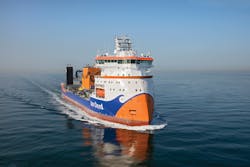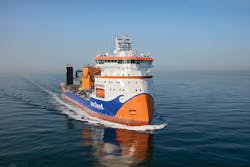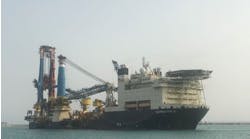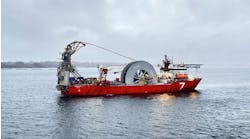Bravenes, VanOORD’s NEWEST flexible fallpipe vessel, started its first offshore installation jobs shortly after undergoing a naming ceremony in Rotterdam. This is the third vessel in the company’s fleet of flexible fallpipe vessels after Nordnes and Stornes, built in 2001 and 2011, and the most versatile in terms of its subsea rock installation (SRI) capabilities.
Van Oord committed to the investment in 2014 based on growing demand time for SRI works from both the offshore oil and gas sector and the rapidly expanding renewable energy and subsea power market. Even during the subsequent oil price collapse, CEO Pieter van Oord reiterated the board’s confidence in the offshore sector’s long-term future. Following delivery from the Xiamen Shipbuilding Industry Company in China, the vessel was christened at Rotterdam’s Wilhelminakade pier in May of this year, departing shortly afterward for Norway to work on various North Sea projects before heading east in July to support the Nord Stream 2 pipeline construction in the Baltic Sea.
The Bravenes en route to an offshore project. (Courtesy Van Oord)
All three of the company’s flexible fallpipe vessels have different features. Nordnes, which was upgraded in 2005, is a DP-2 vessel with tunnel thrusters at the bow and stern and two retractable thrusters, generating a total of 17.6 MW of power. It is designed to place rock for pipeline stabilization or seabed stabilization in water depths of up to 1,200 m (3,937 ft), with a dumping capacity of up to 2,000 metric tons/hr (2,205 tons/hr). Stornes, 175 m (574 ft) long with a draught of 10.6 m (35 ft), has three bows and two retractable thrusters (16.57 MW). Its flexible fallpipe operates through a moonpool in water depths of up to 1,300 m (expandable to 1,800 m), at a dumping rate of up to 2,000 metric tons/hr.
Bravenes, which is 154.4 m (506.5 ft) long, 28 m (92 ft) broad and 14,000 dwt, is a DP-3 vessel equipped with two 1.3-MW azimuth thrusters, two 1.5-MW tunnel thrusters and two 2-MW retractable thrusters (total installed power 16.4 MW). It has ice class 1A notation from Bureau Veritas, which means it can sail the faster northern route to the Far East during the summer months when icebreaker vessels ensure a clear passage across the Arctic Ocean. Its maximum speed while carrying its full 12,000-metric ton (13,228-ton) load is 13 knots, with onboard accommodation for 60 personnel, and 45 days endurance.
Van Oord claims that Bravenes is the most advanced SRI vessel on the market, capable of operating in three modes. One is through a moonpool, in water depths of up to 1,500 m (4,921 ft); another is with the entire flexible fallpipe tower skidded over the vessel’s side, allowing it to work close to offshore constructions such as oil and gas platforms or wind turbines; and third, through a 1.5-m (4.9-ft) tall tremie pipe, again over the side, mainly for shallower water operations or close to structures such as monopole wind towers, in this case placing rock to protect the foundations. In addition, the vessel is designed to install a wide range of rock sizes: the largest, up to 500 kg, is typically for offshore wind farms or subsea cables in shallower water to provide better protection and stabilization in waves and currents.
According to Koos van Oord, general manager of Van Oord Offshore, the launching and recovery system of the vessel’s fallpipe, designed entirely in-house, is an innovation that no other SRI vessel can provide. “The way we store, launch, and maintain the fallpipe makes the operation more efficient and safer, due to the increased level of automation (with reduced manual tasks). In addition, the conveyor belt is made of steel instead of rubber – following practice in the mining industry – to allow the vessel to handle the larger sizes of rock.”
All three of the company’s fallpipe vessels are scheduled to work on a variety of projects through the end of 2019, and despite the advanced capabilities of the Bravenes, there are no plans to phase out either of the older ships. Earlier in 2018 Nordnes installed rock for BP’s West Nile Delta development, 65-85 km (40-53 mi) offshore Alexandria in the Egyptian sector of the Mediterranean Sea. This was over the deeper water pipeline sections, in depths of up to 650 m (2,132 ft). Nordnes and Stornes began working on the various phases of the project, which is designed to tie in gas from five deepwater fields, in 2016. •




